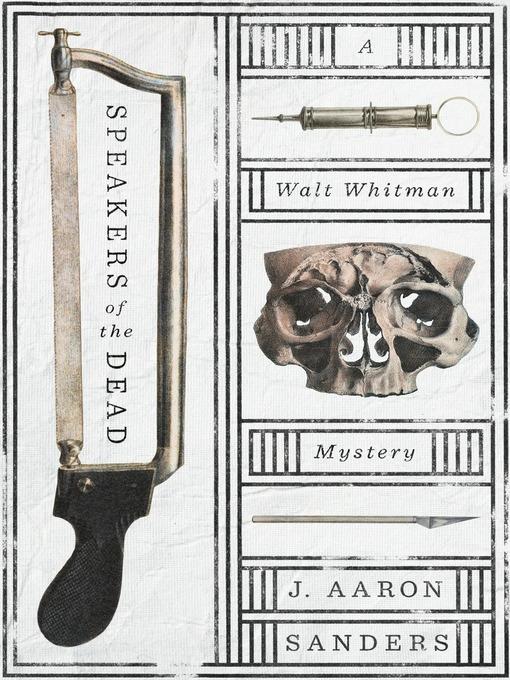
Speakers of the Dead
A Walt Whitman Mystery
کتاب های مرتبط
- اطلاعات
- نقد و بررسی
- دیدگاه کاربران
نقد و بررسی

December 14, 2015
Early in Sanders’s gripping first novel, set in New York City in 1843, Walt Whitman, a 23-year-old reporter, tries but fails to rescue a friend of his, Lena Stowe, from the hangman at the Tombs, the city jail. Lena is executed for the murder of her husband, Abraham, with whom she cofounded a women’s medical college. In his subsequent quest to prove Lena’s innocence, Walt tangles with a pair of tough grave diggers and a powerful real-life Tammany Hall boss, Isaiah Rynders. Lending a hand is Edgar Allan Poe, who has recently serialized a story in a magazine that’s a thinly fictionalized account of the Mary Rogers murder case, in which Abraham was involved. Meanwhile, Henry Saunders, Walt’s lover, stakes out a cemetery. The author addresses the then-controversial issue of anatomical dissection and imbues all his characters, even the villains, with humanity. Fans of Daniel Stashower’s account of the Mary Rogers case, The Beautiful Cigar Girl, won’t want to miss this auspicious debut. Agent: Jeff Kleinman, Folio Literary Management.

January 1, 2016
A young Walt Whitman battles conspiracy, corruption, and wrongful execution. Scandal roils New York City in 1843 when Abraham Stowe, co-founder of the Women's Medical College of Manhattan and cousin by marriage to Harriet Beecher Stowe, dies of poisoning. His wife, Lena, stands trial for murdering him, supposedly in a jealous rage over his infidelities; Stowe himself had been accused of killing a young mistress in a botched abortion. An idealistic 23-year-old reporter for the New York Aurora, one Walt Whitman, doesn't believe either of the Stowes capable of those crimes. As their lodger and friend, he feels closer to them than to his parents. Despite all his efforts, however, Lena is convicted and hanged. With the help of his boss, Henry Saunders, who is also his tentative lover, Whitman dedicates himself to clearing her and her husband's names. The Stowes had their enemies: anti-dissection protesters who try to destroy the college and opponents of Stowe's latest draft of the Bone Bill, legislation that would have provided legal means for medical students to get cadavers for their research. Without that bill, body snatching remains a thriving industry in New York, and Walt suspects that one of the so-called resurrectionists could have killed Abraham. Henry helps Walt set a trap that leads to a powerfully connected body snatcher, Samuel Clements, and another murder that Walt witnesses. He escapes from Clements, but only just. As he digs more deeply into the past and present murders, wallows through the boss-run politics of New York City, and tries desperately to exonerate the Stowes, he realizes how dangerous an enemy he's made. Squeamish readers will probably want to skip first-timer Sanders' many loving descriptions of dissection. Further attention to detail and setting, the historical characters, and the hero's string of perils unfortunately don't quite add up to a compelling narrative.
COPYRIGHT(2016) Kirkus Reviews, ALL RIGHTS RESERVED.

Starred review from February 1, 2016
In 1843 New York City, Elizabeth Blackwell is under the tutelage of Abraham and Lena Stow, studying to become the first female U.S. medical doctor. When Abraham is murdered, Lena is taken into custody, convicted, and hanged. Vowing to exonerate his late friend, young reporter Walt Whitman investigates and finds a link between Abraham's killing and the underground world of the body snatchers, or resurrection men, who sell stolen corpses to medical colleges. He also works with Blackwell and the other students of the Women's Medical College to keep the school open as crowds protest the use of cadavers (and the methods in which they are procured) in their training. VERDICT This elegant literary mystery from Sanders (English, Columbus State Univ.) makes a fine debut, bringing to vivid life one of America's greatest poets and presenting a fresh perspective on a less-familiar period of U.S. history. An excellent choice for readers who enjoyed Louis Bayard's The Pale Blue Eye, which featured a young Edgar Allan Poe as a sleuth.
Copyright 2016 Library Journal, LLC Used with permission.

February 1, 2016
In 1843, New York journalist Walt Whitman, yet to pen Leaves of Grass, investigates the murder of his friend and teaching-hospital founder, Dr. Abraham Stowe. Stowe's wife, Lena, is sentenced to hang for allegedly killing her husband. What really happened is a mystery wrapped in layers of deceit, ulterior motives, shady politics, and grave robbing. Walt has stumbled into a hornet's nest of citizens and city leaders in vociferous disagreement over abortion, cadaver procurement and dissection, and, above all, women doctors, some of whom are using creative, even violent methods to skirt the law. Stowe's murder is just one death of many, and Walt risks his life to speak of the inconvenient dead. Readers must make a quick mental adjustment to Whitman-as-sleuth, but Sanders mesmerizes with details both gruesome and descriptively captivating, while characters take on lives of their ownand not the ones you might expect. This is both the author's first novel and the first of a series that brings Whitman to vibrant life, in a fashion similar to what Stephanie Barron has done for Jane Austen and Gyles Brandreth for Oscar Wilde.(Reprinted with permission of Booklist, copyright 2016, American Library Association.)

























دیدگاه کاربران